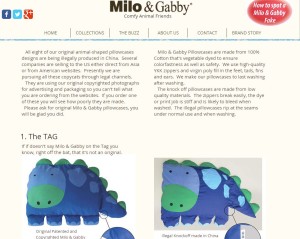Is Amazon Liable For IP Violations By Its Marketplace Vendors? (Forbes Cross-Post)

I wonder if trying to educate consumers about fake animal-shaped pillowcases just makes consumers more interested in finding the cheaper option?
The case
In 2013, Milo & Gabby sued Amazon in 2013 alleging a variety of intellectual property claims. In 2014, the judge dismissed several of those claims and narrowed the lawsuit to three claims:
* copyright infringement. Merchants allegedly used Milo & Gabby’s copyrighted marketing photos to advertise their knockoff goods. Even if true, the court says this isn’t Amazon’s direct responsibility because “the content of the detail pages and advertisements was supplied by third parties via an automated file upload system, and did not originate from Amazon.” In addition, Amazon qualified for the online safe harbor for user-caused copyright infringement (17 USC 512(c)) that Congress created in 1998 as part of the DMCA. On the key question of Amazon’s ability to control merchants’ infringing behavior, the court concluded that Amazon lacked “practical” control because it can’t “analyze every image it receives from third party sellers, compare the submitted image to all other copyrighted images that exist in the world, and determine whether each submitted image infringes someone’s copyright interest.”
* trademark infringement. Among other things, the court says Amazon wasn’t the seller of the allegedly infringing items because its “third-party sellers retain full title to and ownership of the inventory sold by the third party.” Thus, Amazon didn’t commit trademark infringement.
* design patents. Design patents protect non-functional “ornamental” product designs. In contrast to utility patents, which get lots of attention, most academics and practitioners routinely ignored design patents–until Apple scored a huge damage award in its fight against Samsung based on design patents. Now, lots of folks are keenly interested in design patents.
A design patentholder has an exclusive right to offer the patented item for sale. The court says a factfinder could conclude that Amazon offered the knock-offs for sale, even though the merchants posted the listings. The court explains:
While Amazon notes that the item is “sold” by a third-party vendor and “fulfilled” by Amazon, the fact that the item is displayed on the amazon.com website and can be purchased through the same website, could be regarded as an offer for sale….Likewise, looking at the website, a potential purchaser may understand that his or her assent is all that is required to conclude the deal. Indeed, the website notes the price, allows the buyer to choose a quantity, and allows the buyer to then conclude the purchase.
As a result, the court sends the design patent issues to trial.
Implications
This case implicates a perennial cyberlaw issue: is an online marketplace just a venue provider for its merchants, or is it the actual retailer? However we might have answered these questions in the past, marketplace operators play increasingly greater roles in merchant transactions–not only do they provide advertising services to merchants, but they may run the ordering software and process the payments. In Amazon’s case, merchants often store their inventory in Amazon’s warehouses and have the orders fulfilled by Amazon’s warehouse workers. So while merchants nominally set the item’s price and retain inventory ownership risks, Amazon provides many of the other functions we associate with “retailers.” On that basis, Amazon faces constant–and perhaps growing–exposure that it will be treated like the retailer of marketplace offerings, with all of the associated legal risks.
This court’s opinion demonstrates this schizophrenia over how to characterize Amazon’s marketplace. When discussing trademarks, the court says Amazon wasn’t the seller; while regarding design patents, Amazon may have offered the items for sale. Arguably, these conclusions are difficult to reconcile.
If Amazon defeats the design patent claims at trial, this case may become an expensive but ultimately inconsequential lawsuit for it. However, should the trial conclude that Amazon did “offer for sale” the design patented items, then the holding will put significant pressure on Amazon’s characterization of its marketplace. Many major vendors supplement their copyright and trademark protection with design patent protection, and those vendors could pursue Amazon for design patent infringement even if Amazon can completely avoid copyright and trademark liability.
Amazon’s options to mitigate any design patent risk are unappealing. There’s no notice-and-takedown requirement for direct design patent liability, so Amazon might need to prescreen merchant items for design patents; or it might ignore the problem and hope that works out OK, knowing that it may not. As a result, Amazon really, really wants to win the design patent claims; and should it lose at trial, Amazon will certainly seek an appeal that would have high stakes. (Then again, this case probably will be appealed no matter what happens at trial).
I reached out to both sides for their comments about this ruling. Philip P. Mann, Milo & Gabby’s counsel, wrote me:
It is amazing the lengths the courts will go to these days to protect companies like Amazon.
Without her knowledge or permission, the “largest Internet-based retailer in the United States” runs on-line ads showing not only my client’s actual copyrighted products but her own children as well. Amazon collects and pockets money from would-be buyers. It substitutes a cheap knock-off product for the one actually shown. It puts the knock-off in a box clearly marked “Amazon” and delivers it to the buyer in place of the genuine product depicted. And to top it off, my client gets a bad review when the buyer is disappointed in the knock-off.
According to the court, this is perfectly all right and beyond the reach of the law — because Amazon doesn’t actually sell anything.
Got it.
As usual, Amazon didn’t respond to my inquiries.
Case citation: Milo & Gabby, LLC v. Amazon.com, Inc., 2015 WL 4394673 (W.D. Wash. July 16, 2015). The complaint.